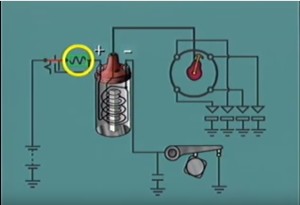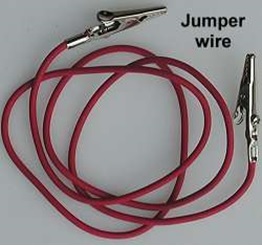Ballast Resistor Caused Shutdown
Ballast Resistor Caused Shutdown can happen in 12volt vintage Plymouths, Dodges, and other Chrysler Products at any time and leave you stranded unless you are in the know.
The Bottom line is to carry a spare Ballast Resistor and/or a jumper wire & know what to do. That’s the below topic……to get you prepared for the eventual event.
First up is getting in the know; simply stated the ballast resistor reduces the 12volt battery power to a lower voltage close to 6 volts before sending the power to the ignition coil. Chrysler products are factory setup to send a full 12 volts to the coil during the start and crank stage for best firing during that challenging period of time to awaken your sleeping mill. Once the engine starts (i.e. you let up on the key and send it into the run position) then there is only 6 volts sent to the coil to prolong ignition component life. The magic voltage reduction occurs in a Ballast Resistor usually mounted on the Chrysler Product Firewall (on the engine side).
The way this dual voltage is achieved is by having two circuits coming out of the ignition keyed switch; a start circuit and a run circuit. The start circuit ignition switch wire goes to the output side of the ballast resistor and bypasses the ballast resistor to enable the full 12 volts (or a little more) to go to the coil while the engine is cranking.
When the key is placed in the run position (after cranking & starting the engine) then the ignition switch run circuit supplies 12volt power to the input side of the ballast resistor and current flows thru the resistor which causes the voltage to be around 6 volts at the Ballast Resistor output terminal. See this simplified diagram in the following video discussing the Ballast Resistor use:
https://www.youtube.com/watch?v=PoDh4W1PQDI
You probably guessed already what happens when a Ballast Resistor goes bad……the engine starts OK but doesn’t keep running! It’s a sure sign that the Ballast Resistor has gone bad. At least the chances are very high for that scenario! You could test the Ballast Resistor under load to see if it is acting normally such as suggested in this video:
What to do if this happens while you are out and about? Just get a jumper wire and jump the Ballast Resistor input terminal to the output terminal……. a full 12 volts will exist during the ignition switch run position. This is for an emergency and gets you going and out of trouble. Jumping the Ballast resistor is not for the long haul however as the downstream ignition components are only designed for small doses of a full 12 volts.
So the jumper wire method gets you to a better location where you can change the Ballast Resistor since you are carrying a spare Ballast Resistor because you are in the know. The correct wrench or socket also needs to be with you to pull off the change out.
Here is a Slant Six Forum review of the above subject:
You will find a picture there of the jumper wire to carry in your glove box:
Also carry a spare ballast resistor matching your year and make of car since ballast resistors varied over the 60’s thru 80’s.
Older style:
Newer style:
You can now understand the following that happened to me. Every day when I drove home I drove past an elderly gentlemen resting on his rocker on the porch in the shade. Parked outside was his 67 GTX all polished up in the driveway and in the shade. This happened for months. Then on multiple days he was on the rocker and there was no car outside. So I pulled into his yard in my 66 Coronet, introduced myself, and told him I missed his car being parked outside.
His response was the car wouldn’t run but would turn over and briefly start. So I offered to start and run it in less than 5 minutes. Surprised by such a bold offer he went and lifted the garage door and declared “I gotta see that!” So I grabbed my jumper wire from the Coronet trunk, lifted the GTX hood, attached the jumper wire to both Ballast resistor terminals, and sprayed some starting fluid in the big carb since the car had sat for some time. He turned the ignition key and the GTX engine sprung into a nice fast idle. I had a new friend and he let me change the Ballast Resistor on his pride and joy!
The Bottom Line: knowing about a Ballast Resistor Caused Shutdown can not only help yourself but others as well as long as you have the jumper wire and spare Ballast Resistor with you as you cruise about in your 12 volt Plymouth, Dodge, or Chrysler Product. You might want to also carry the above Ballast Resistor simplified circuit diagram so you can explain what you are proposing for your new found friend’s pride and joy.
Modified ignition systems may or may not have a Ballast Resistor. If you have done the High Energy Ignition (HEI) modification to your 60’s and later Chrysler Product then there is no Ballast Resistor required since the coil accepts a full 12 volts. Stay tuned for background on that modification which can make your early Dodge or Plymouth start like modern iron and fire thru extremely poor combustion conditions. It will outperform a standard Chrysler Electronic Ignition system and we’ll use the Sun Tester to show the remarkable difference!




